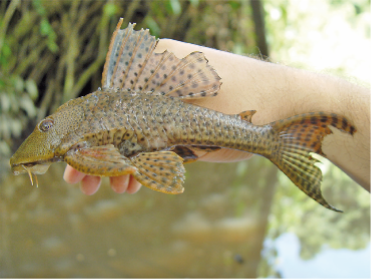
The Problem and Motivation Behind:
Shopna (18 years old) and her team grew up in fishing communities in Dhaka, Bangladesh, where they witnessed firsthand the spread of the sucker fish[1], which were consuming other valuable fish species. As a result, fishermen often discarded sucker fish because they were not suitable for human consumption and negatively impacted other fish populations.
Seeing the sucker fish being wasted sparked an idea in Shopna and her team. They began to think about how they could turn this undervalued fish into a resource that could financially support their families while also being innovative. At the same time, they noticed a growing demand for affordable pet food, as many households kept cats and dogs. However, most of the available pet foods were imported and expensive. This realisation led them to consider transforming sucker fish into a sustainable, low-cost pet food option.
The Innovative Solution:
“We wanted to do something different, something that could make us self-reliant while also solving a real problem. When we realised that sucker fish could be used to make pet food. It seemed like a practical way to reduce waste and create a business”– Shopna.
Through a Design Thinking process, Shopna and her team started by understanding the challenges faced by local fishermen and pet owners. They realised that sucker fish had no significant market value, while pet food was expensive and not always available. They brainstormed different ways to process the fish. Eventually, they decided on sun-drying the fish and mixing it with grains like maize and rice to create an affordable and nutritious pet food. They tested the pet food by feeding it to local cats and dogs and ensuring it was non-toxic through laboratory analysis.
The community’s feedback has been positive too. Pet owners appreciate the affordability and quality of the food, and local fishermen are happy to have a reliable market for sucker fish. “When they saw that our product was useful and that it didn’t harm the animals, they started supporting us,” Shopna noted. Accordingly, they started to work from the roof of a house, but with time and support, they managed to set up a small office to handle production and orders. They now source Suker fish from local fishermen at a low cost, then process them into dry chips for pets. In this phase, they are depending on online orders and delivering them to customers within Dhaka.
“Before, we depended on our families for everything. Now, we earn money, support ourselves, and even contribute to household expenses.” – Shopna.
Processing sucker fish into pet food became a source of income for Shopna and her team, motivating them to and plans to scale up their production in the future. Their solution also contributes to protecting rivers and streams from sucker fish invasion, while also reducing the import of animal feed from abroad. This not only helps maintain local biodiversity but also saves foreign currency that can be allocated to other uses.
Lessons Learned and Addressing Challenges
With support of Youth Innovation Lab (YIL), Shopna and her team received a seed grant from that allowed them to buy special tools required for drying fish and start their production. Also, winning the Champion Award at the Youth Innovation Lab gave them recognition and credibility, making it easier to gain customers and expand their operations. They also received training and mentorship support that enabled them to learn how to manage their operations and financials, and market their pet food for the targeted customers.
Reflecting on their learning, Shopna identified two major lessons learned from their experience:
- Ensuring family support is crucial when starting a business, especially for females—girls and young women like Shopna often face opposition from their families when they want to pursue entrepreneurship or step outside their homes. Families are often concerned about their safety and reputation. The Youth Innovation Lab (YIL) team played a significant role in addressing this challenge by speaking directly to the families of Shopna and her female teammates, explaining the importance of economicindependence for them. They worked to convince the families to allow their daughters to venture outside and pursue their business aspirations. “We were not allowed to move out of the house. When we told the Innovation Lab team about our problems, they came to our house, talked to our parents, and explained to them that girls should be self-dependent,” Shopna recalled.
- Using evidence to gain customers’ trust in fish-based pet food – Since fish-based pet food was not common in their area, some people were hesitant to buy it. To address that, Shopna and her team with support from YIL tested their pet food in fishing institutes, proving that it was safe and nutritious for pets, which helped build trust among customers.
Next Steps and Future Aspirations:
“If we get more support, we can add more products. I think sucker fish’s leather is thick enough to make useful items. We are thinking along these lines,” Shopna shared.
Looking ahead, Shopna envisions expanding the business by:
- Developing more pet food varieties, including products for different types of pets.
- Investing in better drying and processing equipment to increase production efficiency.
- Exploring the potential of using sucker fish leather to create other products, such as pet accessories.
- Setting up a small retail shop to increase visibility and customer access.
[1] Also known as the suckermouth catfish.
N.B. The attached photo is free to use from Wikipedia https://en.wikipedia.org/wiki/Hypostomus_plecostomus#/media/File:Hypostomus_plecostomus_-_Rapha%C3%ABl_Covain.png